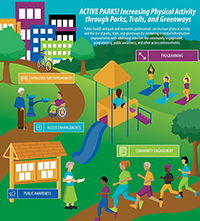Parks and recreation is vital to community health and well-being. Local park and recreation agencies connect every member of the community to essential programs, services and spaces that enhance quality of life. In this role, parks and recreation serves as a key social driver of health, creating opportunities for all people to thrive where they live, learn, work, play and age.
Active Parks! Implementation Guide
According to the guidance from the Community Services Preventive Task Force, park and recreation and public health professionals play a role in ensuring all community members have equitable opportunities to get active. The Active Parks! Increasing Physical Activity Through Parks, Trails, and Greenways recommendation states that combining 1) essential infrastructure improvements with 2) additional activities like those listed below can increase the use of parks, trails and greenways for physical activity.
To support park and recreation and public health professionals advance the Active Parks! Recommendation, NRPA developed the Active Parks! Implementation Guide. It provides an overview of the recommendation, a step-by-step process to equitably implement it, and case studies from four projects aligned with the recommendation.
Access the Guide
Infrastructure + Additional Activities = Increased Physical Activity
As outlined in the guide, infrastructure improvements can refer to developing new or making improvements to existing parks, trails or greenways. Combining infrastructure improvements with the following activities is linked to increasing physical activity at parks, trails and greenways:
- Community Engagement — Build authentic, ongoing engagement with community members, particularly those who have historically faced barriers to the services and facilities parks and recreation provides. Community member surveys, community advisory boards, and community outreach at events are all ways to engage community members.
- Programming — Offer structured opportunities for physical activity, social interaction, and other health benefits that are designed to serve all community members. Host walking groups, exercise classes, organized sports, adaptive activities, or out-of-school time programs.
- Public Awareness Activities — Reach and inform all community members about programs and services through banners, fliers, promotional campaigns, event days, and social media.
- Access Enhancements — Make improvements that increase access to parks, trails, and greenways for all community members. For example, Americans with Disabilities Act (ADA) enhancements, culturally relevant signage, street crossings that create transportation connections, and expanded hours of operation all increase access to these spaces.
Advancing Health Equity Through Active Parks!
Using the Active Parks! Implementation Guide, park and recreation and public health professionals can take action to address advance health equity in their communities. Prioritizing and engaging the people who have historically been excluded from the benefits that parks, trails, and greenways provide is critical to equitably implementing this recommendation. Decreasing health inequities improves the health of all individuals and their communities.
Use this communications toolkit to share the message about the Active Parks! Increasing Physical Activity Through Parks, Trails, and Greenways recommendation and the accompanying implementation guide.


